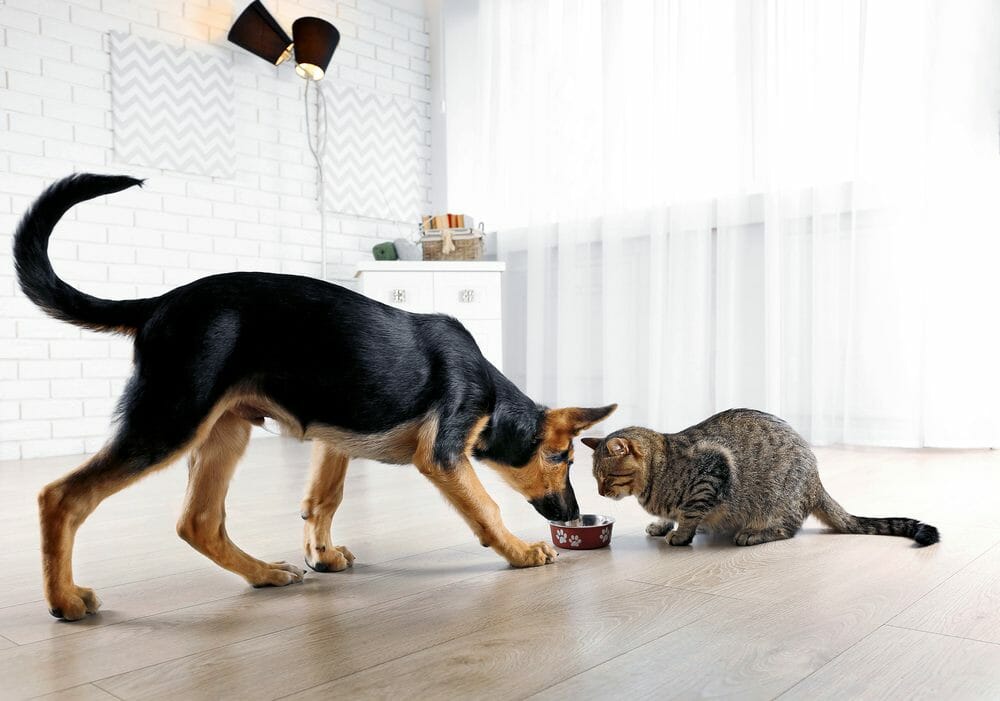Cat food for dogs… Is it safe? If you have both a dog and cat, you may have noticed your dog sneaking some cat food. Regardless of age, breed, or how well-behaved they are, most dogs will sniff out and snack on the food if it’s available. So, the big question.. is that safe for dogs?
Short Answer
Although a bit of cat food on occasion isn’t immediate danger, you shouldn’t offer it regularly. Cats and dogs may venture into each other’s bowls from time to time, but it shouldn’t be a regular thing. As obligate carnivores (or hyper-carnivores), cats have a biological necessity to eat meat. On the other hand, dogs are omnivores and need a more balanced diet to remain healthy.
Below is everything you need to know about the difference between dog and cat nutrition. You can also learn more about safer options for your dog from Spot and Tango’s recipes that are yummier than cat food and meet all your dog’s nutritional requirements.
Difference Between Dog and Cat Nutrition
As omnivores, dogs require a more varied diet that includes both plant-based and animal-based ingredients. As true carnivores, cats can solely eat animal protein and therefore have higher fat and protein requirements than dogs.
Extensive research has helped determine the foods that are nutritionally beneficial for a dog. Dog food companies often follow AAFCO standards to formulate the food appropriately. There are also guidelines for cat nutrition. Suggested servings and nutritional content differs for dogs and cats.
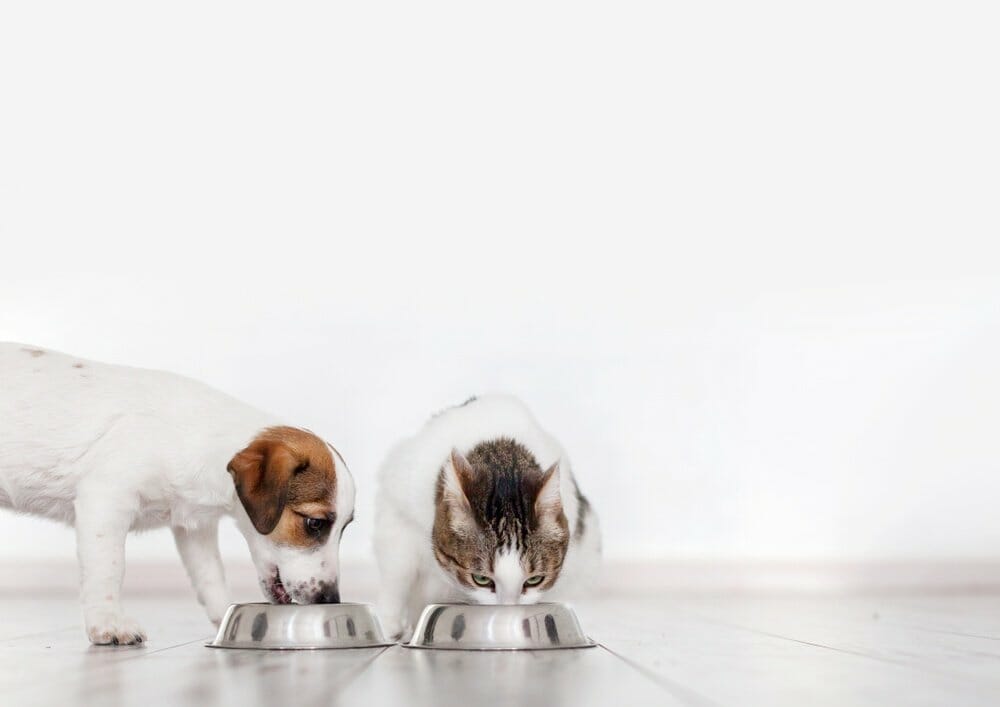
Cat food is typically much higher in meat-based protein with more fat content, making it fragrant. And therefore tasty, enticing, and appealing to dogs. However, it doesn’t mean they should eat cat food just because they crave it.
While dogs only require ten essential amino acids, cats need 11 to be present in their diet. The extra one, taurine, is critical for vision, a healthy immune system, digestion, and heart function.
Is Cat Food Bad for Dogs? Can Dogs Eat Cat Food Occasionally?
Occasionally eating the cat’s food isn’t bad for the average adult dog. However, if your dog eats it regularly or in place of its own food, the nutrient imbalance can lead to health complications.
Cat food doesn’t have the correct balance of protein, fat, fiber, and nutrients dogs need to stay healthy. Though it’s not toxic to dogs and if it happens occasionally, there’s no immediate cause for concern.
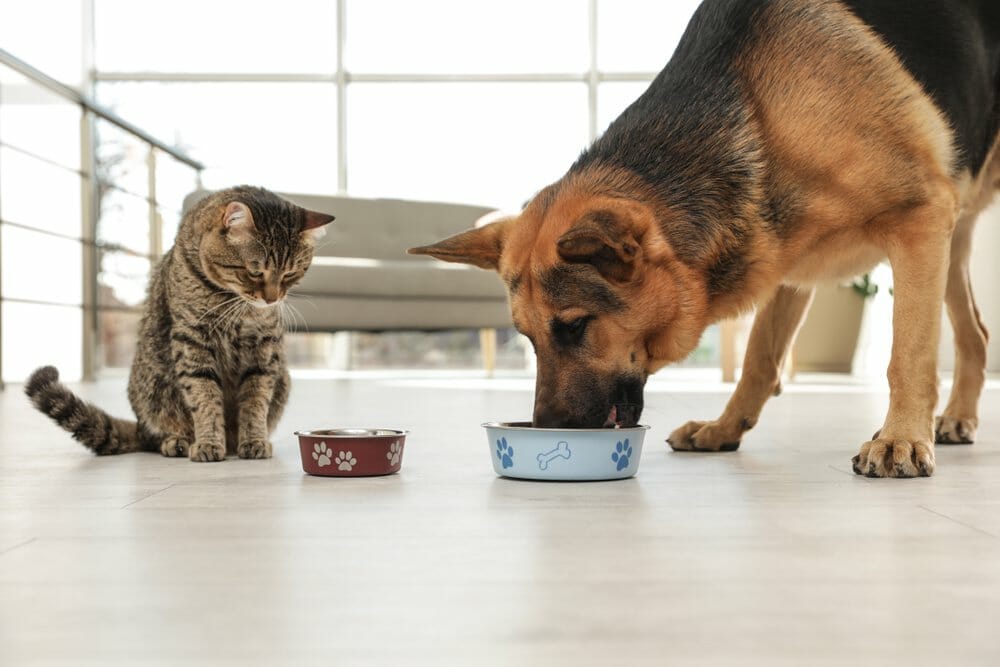
However, if your dog switches to mostly eating the cat’s food, they can suffer from various medical conditions.
Some common issues include:
- Gastrointestinal upset – anytime you introduce anything new into your dog’s diet, you can expect gastrointestinal distress. Dogs with sensitive stomachs can also experience diarrhea or vomiting that’s usually short-lived, but if it continues for more than a day, you should contact your vet.
- Obesity and pancreatitis – food for cats is high in fat and can make your dog overweight or obese. This is particularly noteworthy for already-obese dogs or those predisposed to developing pancreatitis like Schnauzers. Certain dogs may need to consume low-fat diets to limit pancreatic inflammation or promote weight loss. Pancreatitis requires immediate medical care. Common symptoms include a hunched back, abdominal pain, appetite loss. Other symptoms include weakness and lethargy, fever, and a distended abdomen.
- Liver and kidney problems – dogs with liver or kidney disease should consume small to moderate amounts of protein. Limited protein promotes the healthy functioning of these organs. The excess protein found in cat food can result in complications and exacerbate health issues.
- Bloating – bloating can be a big concern. In large enough quantities, your dog’s stomach may fill with food and air causing bloat, which can be fatal. A hard abdomen with vomiting where nothing comes out can be a sign your dog is bloating and requires immediate medical attention.
When Can Dogs Have Cat Food?
In some specific situations, cat food may be an alternative to many dog foods. For example, if your dog is battling cancer, has a poor appetite, or muscle loss. Cat meals are often more palatable and provides more calories and nutrients per serving. Additionally, compared to some human food, the food for cats may be healthier option (more nutrients and less fat).
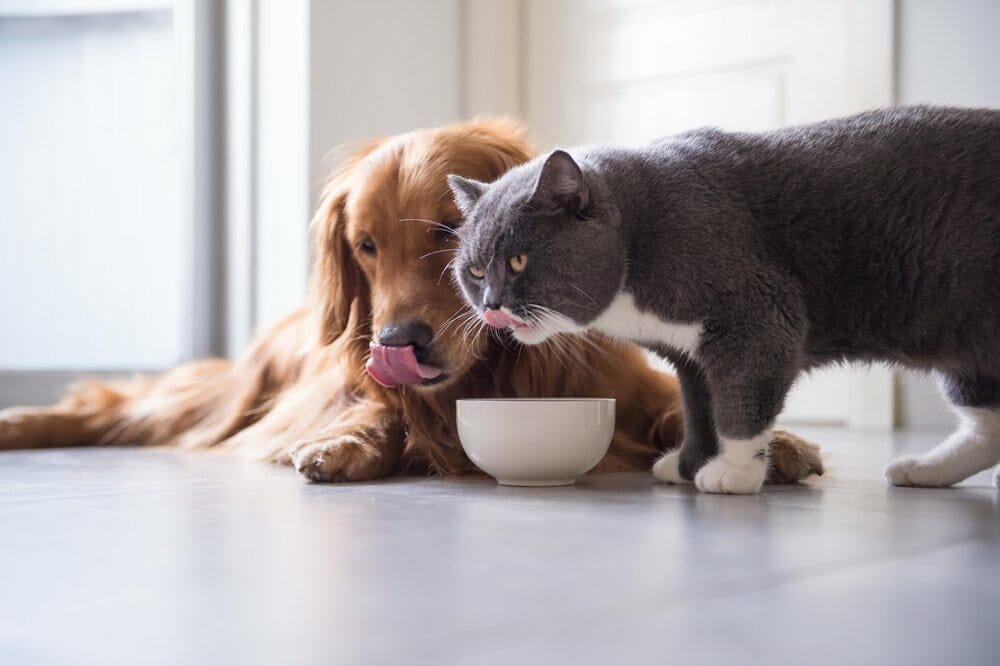
Safe Treat Option for Your Dog
Stale, unsavory kibble is one reason a dog ventures into the cat’s bowl, which is flavorful with a meaty aroma. As long as it’s in small doses, a little treat of the cat’s food isn’t terrible for your pup.
Try A Fresh Food Instead
If your dog neglects their bowl, provide irresistible dog food that’s balanced based on your dog’s weight and life stage. Through Spot & Tango, create a personalized meal based on your dog’s weight, age, breed, and health goals. Veterinary nutritionists create the recipes to ensure your dog gets a balanced and complete meal prepared in USDA-certified kitchens.
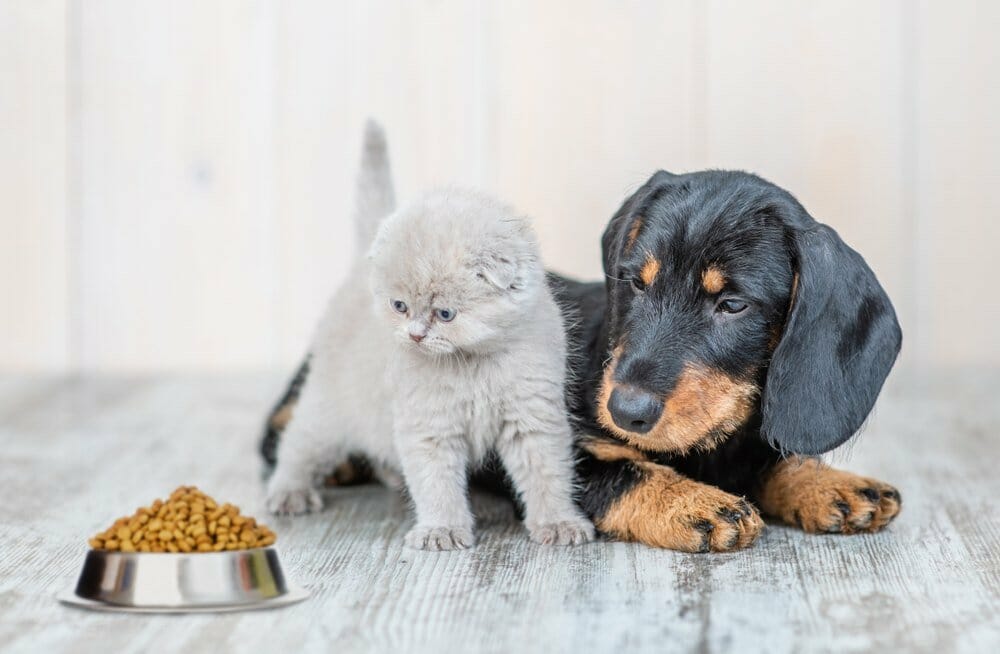
What Recipe Should You Pick?
An all-around favorite is Spot and Tango’s Beef and Millet recipe. It exudes a delectable aroma from the moment you open the food pack, so your dog won’t turn its nose up at the Beef and Millet meal. Carefully created by experienced vet nutritionists, it guarantees a balanced and complete meal for dogs at all life stages, whether they’re pups, adults, or seniors.
If you constantly find your dog eating the cat’s food, it’s likely because they’re a fan of meaty meals and treats. Spot and Tango’s Beef and Millet recipe is an excellent alternative that contains the very best USDA-certified, human-grade prime beef. All ingredients are cooked separately and at the optimal temperature, guaranteeing your dog the best flavors and goodness in every bowl. All the ingredients are mixed just before packaging to create a highly nutritious, fresh meal.
In case your dog suffers from allergies, has a sensitive stomach, is overweight, or is a senior or aging dog with specific special needs, the last thing you want is to have them feeding on cat food. As noted before, eating too much cat food can exacerbate conditions, promote obesity, and lead to gastrointestinal upsets.
Spot and Tango helps you select the right dog food for your pup based on their specific needs and requirements. The best part is that, unlike other pet food, Spot and Tango meals are made to order and are 100% free from fillers, low-quality proteins, preservatives, and additives.
Frequently Asked Questions
Can Dogs Eat Wet Cat Food?
In some situations, wet cat food can be an alternative to the available dog food options. When a dog is experiencing a decreased appetite, muscle wasting, or weight loss (perhaps because of cancer), cat food can be more palatable. It can ensure they get many nutrients and calories instead of not eating at all.
However, better alternatives to wet cat food exist and are more suitable than cat food for dogs with special needs. Through Spot and Tango, you can create a personalized meal plan for your dog based on their needs instead of resulting in cat food.
Experienced vet nutritionists create dog food with your specific dog in mind, so you can rest assured that your dog has a complete and balanced diet. Flavor and aroma are guaranteed, so you can ensure your pup will eat and enjoy the meal despite their situation.
Can Dogs Eat Dry Cat Food? Can Dogs Eat Cat Food Treats?
If your only choice is between human food and dry cat food treats, cat biscuits and cat kibble are the healthier alternative. They usually contain a better mix of nutrients and proteins than regular human food.
However, dry cat food is designed to fulfill the nutritional requirements of a cat, rather than a dog. Dry cat food is high in meat-based carbohydrates without any plant-based ingredients. Eating too much dry cat food can also result in dental problems for your dog because it’s meant to be chewed up by thinner and sharper cat teeth.
Can Puppies Eat Cat Food?
It shouldn’t be a problem if your puppy sneaks some cat food from time to time, but it should never be a replacement for their meals. A proper meal for puppies is crucial because they’re still developing and require a well-balanced, nutritious diet to support their growth.
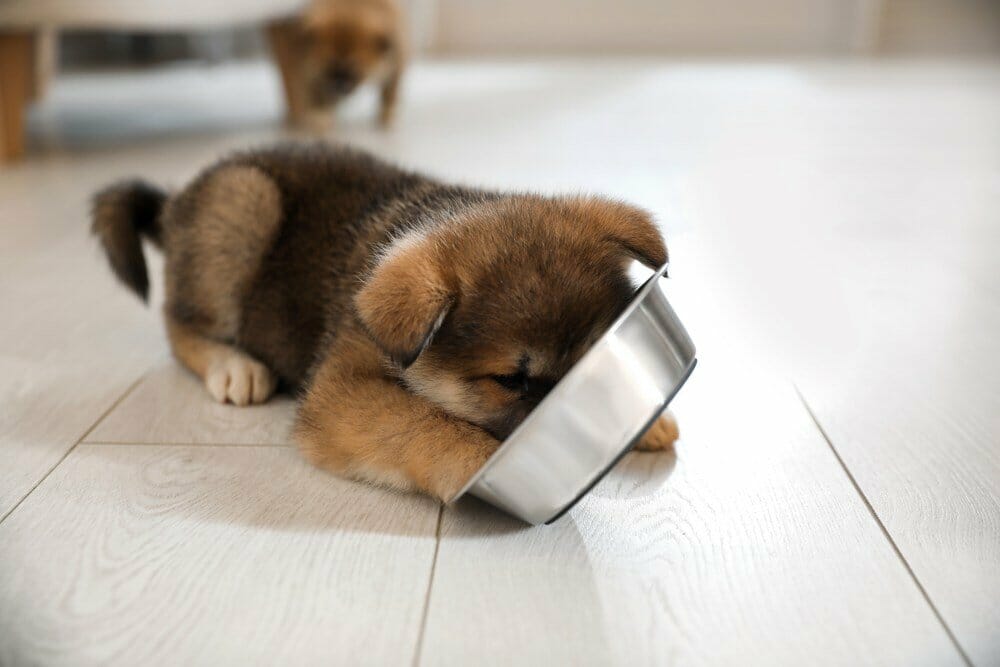
As well as upsetting their stomachs, regularly feeding your puppy cat food can result in obesity and musculoskeletal problems.
How Can I Stop My Dog from Eating Cat Food?
If your dog is constantly eating your cat’s food, there are a few things you can try to discourage and eliminate this behavior.
Remove The Opportunity
If your dog can’t access the cat’s food, they won’t have the opportunity to eat it. You can start by separating your pets during mealtimes by feeding your cat and dog in separate rooms. Having the cat food in a room the dog can’t access will help put some distance between your pup and their newfound love of cat food.
Whether they’re sneaking in snacks of a resident feline’s food or they’re getting it from the neighbor’s yard or house, your first step should be removing the access to cat food.
Put away any uneaten food when your cat finishes, or you can elevate the cat’s bowl to a higher surface. Most cats have no trouble eating their meals in high places where dogs can’t reach, including a dresser, counter, bookshelf, refrigerator, or washing machine.
Make Food Bowls Distinguishable
Your dog probably finds it difficult to distinguish between a bowl full of their kibble and a bowl full of cat kibble. Help your dog know which food is off-limits by making its bowl look very different from the cat’s. You can try distinctive designs, colors, or bowl sizes that your dog can easily distinguish.
The “Leave It” Command
The goal of teaching your dog the “leave it” command is to develop automatic behavior where they first look at you for permission before eating or picking up anything. It may be a tall order, but with the appropriate training, you can help teach your dog that kind of self-control.
You can start by teaching your dog the concept of leaving things alone by the “take it” cue. Once they can successfully ignore treats in your hand before telling them to take it, you can teach them the command to leave it. It will ensure you get to decide what’s safe for eating and not your dog and teach them to control their impulses. By extending the command to anything in the environment, you also ensure your dog always stays safe.
Conclusion
The short answer to whether or not dogs should eat cat food is that it shouldn’t happen regularly. Most dogs find cat meals appealing because of the aroma and flavor of the high meat-based protein it contains. You don’t need to panic if your cat has managed to eat some cat food. Unless they experience an allergic reaction from the ingredients in the cat food, they’ll likely be fine.
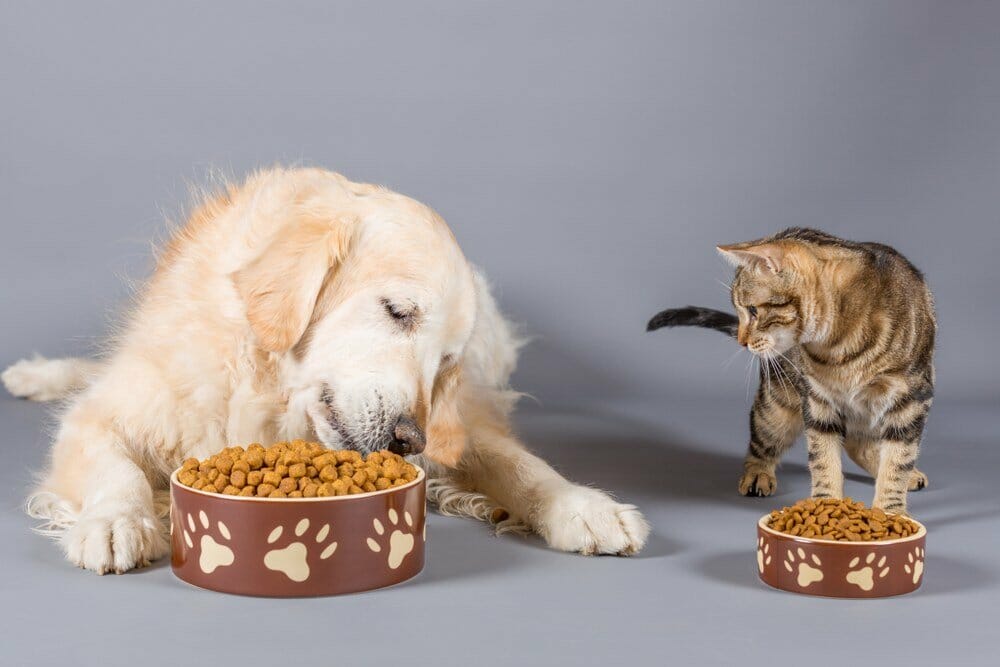
However, if your dog makes a habit of eating cat food, then it can lead to some severe consequences you’d rather avoid. To ensure they don’t get overwhelmed by the irresistible draw of cat food, you need to ensure your dog’s food is equally (or even more) enticing.
Spot and Tango wet and dry meals provide mouthfuls of flavor and aroma that will ensure your dog forgets about cat food in no time. Whether you’re looking for an excellent all-rounder, a meal for sensitive stomachs and allergies, or an all-protein diet, the Spot and Tango range is a fine choice.
Want to Learn More?
- Can Dogs Eat Grapes?
- Is Garlic Bad For Dogs?
- Can Dogs Eat Cranberries?
- Can Dogs Eat Apples?
- What To Do If My Dog Is Vomiting?


